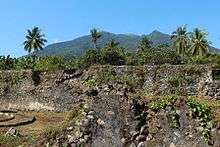Fort Kastela
Coordinates: 00°45′39″N 127°18′43″E / 0.76083°N 127.31194°E


Fort Kastela, Benteng Kastela in Indonesian language, is a ruined fortress located at the southwest coast of Ternate. It is famous for being the first colonial fortification constructed in the Spice Islands of Maluku/Maluku Utara, Indonesia. Built by the Portuguese in 1522, it is also referred to in different languages as São João Batista (Portuguese), Ciudad del Rosario (Spanish) or Gammalamma (Ternatean and Dutch). Today it is locally known as Kastella/Kastela.
In April 1521, a fleet was dispatched by King Manuel I of Portugal from Lisbon under the command of Jorge de Brito. The fleet was given orders to intercept the Spanish fleet of Ferdinand Magellan while sailing towards the Spice Islands from the Americas. Upon making landfall, they were ordered to construct a fortress on Ternate and to establish the Portuguese pre-eminence in the region.[1] The initial fort was named by the Portuguese after Saint John the Baptist, on whose feast day the first stone was laid in 1522. It was completed in 1523.[2] The location selected was on the south-west coast of Ternate, near the Sultan's Court, but 7 km from the island's main reef-free harbor at Talangame. Kastella commanded three narrow passages through the encircling reefs, which allowed small crafts to arrive for loading cloves, but prevented larger vessels from closing sufficiently to bombard.
Several subsequent visitors described the fort as ineffective and poorly constructed, and it was not until the governorship of António Galvão, commencing in 1536, that the defenses were improved significantly.[3] After killing Ternate's Sultan Hairun in 1570, the Portuguese were besieged in their fort by forces of the new Sultan Baab for five years. In 1575, they handed over the fort and retreated to Ambon. Sultan Baab occupied the fort, renamed it as Gammalamma and converted it into his royal palace.[4] Anticipating a Portuguese return, Sultan Baab extensively modified the defenses into a substantial fortress,[5] and constructed an additional fort 5 km to the east, known today as Fort Kota Janji.
In 1605, the newly arrived Dutch VOC captured Portuguese forts on Ambon and Tidore and established a trading base on Ternate. The Spanish (united with Portugal since 1580) dispatched a strong expedition from the Philippines and recaptured Kastella, taking hostage the new Sultan and exiling him to Manila in March 1606.[6] They further modified the Gammalamma defenses into a powerful fortress and renamed it as Ciudad del Rosario. Dutch Admiral Paulus van Caerden, captured by the Spanish in 1610 and held in Kastella, regarded it as "invulnerable."[7] When the Spanish departed from the Spice Islands in 1663, they partially destroyed the defenses which were then occupied by the Dutch.
Today the site consists of ruins spread over a large area, scattered with local houses and bisected by the main island road. There is a monument for the 1575 Ternatean victory over the Portuguese, and sections of the old Portuguese walls and bastions from the Spanish period can also be seen.
References
- ↑ Lobato, Manuel (2012). "Culture and Identity in the Luso-Asian World: Tenacities and Plasticities". ISEAS: Chapter 8.
- ↑ Corn, Charles (1999). The Scents of Eden. New York: Kodansha America. p. 57.
- ↑ "Colonial Voyage". The Portuguese Fort of Ternate. Retrieved October 2013. Check date values in:
|access-date=(help) - ↑ Hanna & Alwi (1990). Turbulent Times Past in Ternate and Tidore. Banda Neira: Rumah Budaya. p. 93.
- ↑ Hanna & Alwi (1990). Turbulent Times Past in Ternate and Tidore. Banda Neira: Rumah Budaya. p. 104.
- ↑ Andaya, Leonard (1993). The World of Maluku. Honululu: University of Hawaii Press. pp. 139–140.
- ↑ "Spice Islands Forts". Retrieved October 2013. Check date values in:
|access-date=(help)
External links
| Wikimedia Commons has media related to Fort Kastela. |
- The Portuguese in Indonesia: the Moluccas and the Lesser Sunda islands
- Forts of the Spice Islands of Indonesia